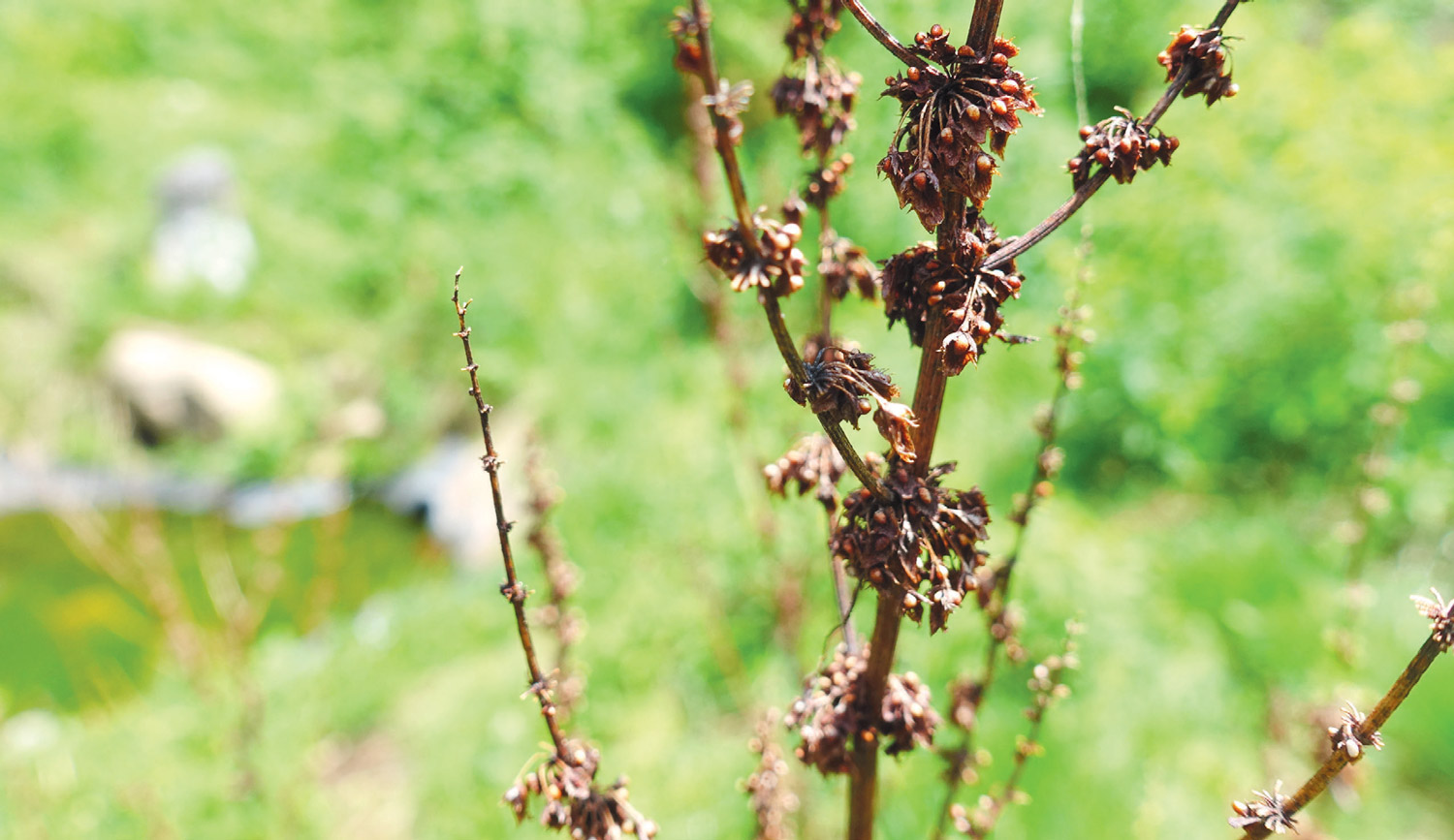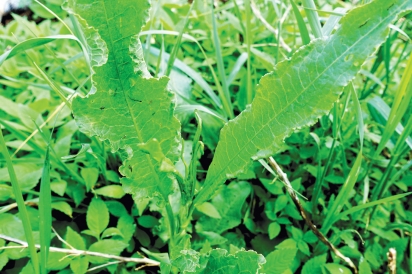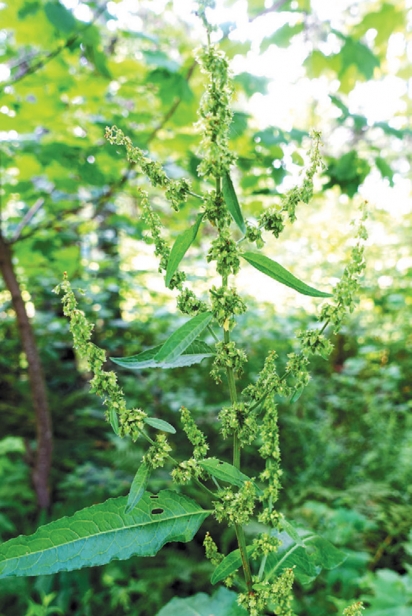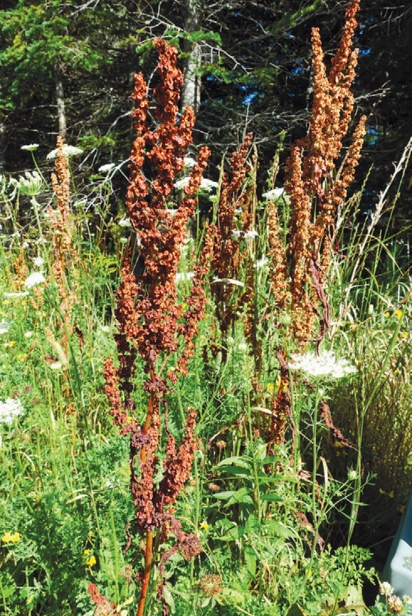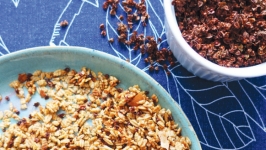Eating Wild: Going to Seed with Curly Dock
Looking for curly dock seedstalks growing along the roadside is an experience akin to searching for your tallest redhaired friend at a party. “Yup, there they are,” you’ll quickly note each time your eyes scan the scenery.
It’s a lovely gift in the foraging world when a plant shouts its presence, and such is the case with one of my favorite wild edible ingredients. When it comes to curly dock’s reddish-brown seeds, once you know what you’re looking for they are nearly impossible to miss.
Curly dock — scientific name Rumex crispus, and also called yellow dock — grows in abundance in green spaces throughout the northeast and can be found along sunny roadsides and trails all around Cape Cod. Arriving in the spring, curly dock begins the season as a basal rosette (or low-growing circular formation) of young, ruffle-edged leaves that emerge from an underground taproot. It is these leaves that give the plant its name, since the leaf-edges are “curly” when looked at from the side.
During the early spring months, curly dock tends to blend in with the surrounding greenery and can be easy to overlook. As spring turns into summer, however, the plant begins to send up a flower stalk that reaches several feet above the surrounding dandelion and clover, and is covered in very small, greenish flowers. But it is around mid-summer, after those tiny, innocuous flowers have gone to seed and begun to dry out, that you’ll merely need to glance along those same green spaces to immediately take note of your neighborhood curly dock. As they dry, both the stalks and the seeds themselves turn an eye-catching rust color that can easily be spotted from a distance.
It is lucky for the enthusiastic forager, then, that the time of year when the plant is easiest to spot is right when the ingredient that I most anticipate, the hearty and flavorful seed, is ready for harvest.
There is a great deal of literature on how to use other parts of the curly dock plant — particularly the leaves and the stalk. I appreciate that others find curly dock’s young leaves to be tasty, but I have generally found them to be too bitter to be of much use as a green vegetable. This is especially true considering the abundance of other, in my opinion, more palatable, wild greens throughout the spring and summer. Many foragers also peel and cook curly dock’s stalks before the flowers appear, but I often let the plant continue to grow on its own at this stage, as there are several other stalks I like to harvest around that same time (burdock and thistle are two that make regular appearances in my kitchen). As soon as those tufts of green seeds become their trademark russet color, you’ll find me waiting with a harvest bag, ready to collect a year’s supply of one of my pantry’s most useful ingredients.
One of my favorite wild food writers, Leda Meredith, aptly describes curly dock seeds and chaff as bran-like. I find this to be the perfect reference point when thinking about the many ways these versatile seeds can be put to use in your kitchen, though curly dock seeds have a slight bitterness (that I enjoy) that bran does not. In my house, we often throw curly dock seeds into the batter of baked goods such as banana, apple or zucchini bread. A hearty yeasted country loaf is also served well with some of the seeds mixed into the dough and pressed into the top before baking. But by far my favorite use for this tasty ingredient is to mix some into homemade granola. In my family, granola is generally my husband Elie’s wheelhouse (as is most of our baking, with the notable exception of pie). After fiddling with the recipes for several years, he’s landed on something we both love and that can be found in a jar on our kitchen counter throughout the year. It is a regular trailside snack on our camping trips and is delicious mixed with yogurt and some fresh berries. Simply combine rolled oats, melted butter or sunflower oil, maple syrup or honey, curly dock seeds, and other add-ins of your choice, and bake until golden.
Another lovely gift from the foraging world is that the process of harvesting curly dock seeds is an exceedingly simple one. Once the tiny seeds — nestled inside flat, vaguely triangular leaf-like parcels — have dried on their stalks, I simply pull them off in bunches, making sure to leave some for local woodland creatures. If the seeds seem completely dry, I store the seed harvest in an airtight jar or Ziploc bag for use throughout the year. There’s no need to remove those tiny seeds from their outer papery casing, since the entire thing is edible. If the seeds don’t seem completely dry when I pick them, I lay them on a tray in the sun or put them in a food dehydrator for a few hours before storing.
Curly dock thrives in disturbed soil, so it is especially important to consider where you are harvesting from since many of those spaces are along highly trafficked roads are likely to be sprayed with harmful chemicals. But if you keep your eyes open for this prolific neighbor, you will almost certainly spy patches in areas less likely to be exposed to less-desirable elements, and a small amount of seeds go a long way in most recipes, adding a great deal of hearty texture and flavor.
One of my favorite aspects of foraging is that, even if you miss the harvest season for one species or don’t love a certain part of a plant, there is always something up next, ready to be discovered, enjoyed, and shared. Curly dock might continue to fly off your radar during the early parts of the growing season, but as you explore your neighborhood in mid to late summer and early fall, glance across the greenery for patches of reddish brown that reach above the surrounding plant life. You might just spot one of your new favorite foraged ingredients, and you didn’t even have to look very hard to find it.
*NOTE: Always consult with trusted experts and refer to foraging books and field guides for 100% positive plant identification before consuming any wild plant. Pick wild plants in moderation, harvesting from areas unlikely to be treated with harmful chemicals, and do not pick plants from protected spaces. As with any new food, integrate wild plants into your diet in small quantities to gauge any dietary sensitivities, and consult with a doctor if you have any questions or concerns about specific health issues or medication interactions.


